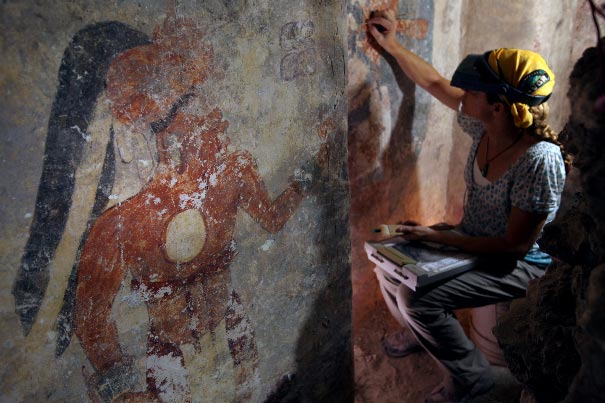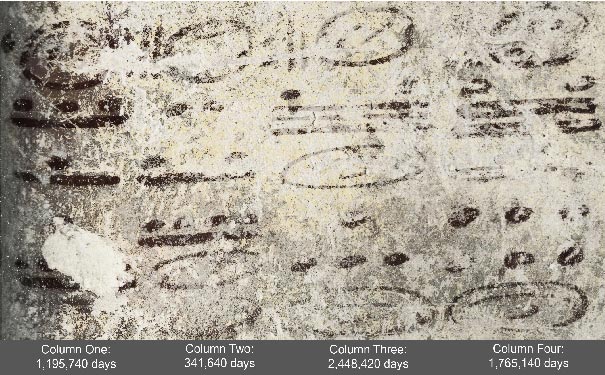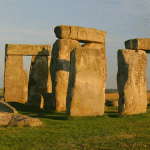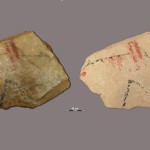
Conservator Angelyn Bass cleans and stabilises the surface of a wall of a Maya house that date to the 9th century. The figure of a man who may have been the town scribe appears on the wall to her left. Image: Tyrone Turner/©2012 National Geographic
A small room in Xultún indicates that the Mayan calendar goes well beyond 2012.
In 2008, William Saturno, who works at the Archaeology Department at Boston University, US, began a systematic archaeological investigation in the Maya ruins of Xultún, northeastern Guatemala.
Xultún was first reported in 1915, and it is considered the largest unexcavated Maya city. It was until 2010 that a mural painting was found in a structured designated as 10K-2. “Max Chamberlain, one of my undergraduate students found remnants of paint in a looters’ excavation during his lunch hour while doing survey and mapping in the residential areas of Xultún. It was most definitely not a temple. It is a room in what seems a residential context,” says Saturno.
The archaeologist believes the room might have been used by scribes or calendar priests, the official record keepers of the community who were tightly connected to the kings. According to David Stuart, Schele Professor of Mesoamerican Art and Writing at the University of Texas, who deciphered the glyphs, the walls can be compared to a whiteboard in an office where people write possible solutions to problems yet to be resolved.
This is the first time that archaeologists find a Maya house containing artwork on its walls. The paintings depict men in black uniforms as well as calendrical cycles such as the 260-day ceremonial calendar, the 365-day solar calendar, the 584-day cycle of the planet Venus and the 780-day cycle of Mars.
“There are tiny glyphs all over the wall, bars and dots presenting columns of numbers. It’s the kind of thing that only appears in one place — the Dresden Codex, which the Maya wrote many centuries later. We’ve never seen anything like it,” says Stuart.
The small room (roughly 2 x 2 metres) was built in the 9th century. Its paintings, astronomical tablets created by the local scribe, try to seek harmony between the sky events and sacred rituals.
“Xultún numbers may have been devised to create schemes for synchronising predictable events connected with the movements of Mars, Venus, the Moon and possibly Mercury. Why these four particular numbers were used, which range in duration from 935 to 6703 years, is uncertain,” wrote the researchers in a paper published in the May issue of the journal Science — their research was supported by the National Geographic Society.
The Dresden Codex, a manuscript consisting of 39 sheets inscribed on both sides that contains astronomical calculations, is perhaps the most-well known Maya calendar, but it ends after 13 baktuns (a baktun is a 144,000-day cycle). The codex has caused a lot of speculation about the end of the world, but there is no sign that the Mayan calendar ends in December 2012.
The numbers painted in Xultún, which predate the codices by some 500 years, reach well beyond 2012. “It’s like the odometer of a car, with the Maya calendar rolling from the 120,000 to 130,000,” said co-author Anthony Aveni, professor of astronomy and anthropology at Colgate University. “The car gets a step closer to the junkyard as the numbers turn over; the Maya just start over.”

Four long numbers on the north wall of the ruined house relate to the Maya calendar and computations about the Moon, Sun and possibly Venus and Mars; the dates stretch some 7,000 years into the future. These are the first calculations Maya archaeologists have found that seem to tabulate all of these cycles in this way. Although they all involve common multiples of key calendrical and astronomical cycles, the exact significance of these particular spans of time is not known. Image: Illustration by William Saturno and David Stuart ©2012 National Geographic
The 2012 end-of-the-world prediction has caused much controversy. “One number on the wall relates a period of more than 6,700 years, of that is counting forward from the date of the painting then, yes [this paintings contain information well beyond 2012]. The year 2012 doesn’t figure into ancient Maya thought in any way. This is a pop culture phenomenon, not one that would be recognised by the Maya,” says the archaeologist.
Archaeologist Sylvanus Morley (1833-1948) mapped Xultún, whose name means “˜end rock,’ in the 1920s, and thousands of structures still remain uncounted. “It’s weird that the Xultún finds exist at all”¦ Such writings and artwork on walls don’t preserve well in the Maya lowlands, especially in a house buried only a meter below the surface,” says Saturno.
There are many other structures at Xultún, and the Mayanists hope to further explore the structures in the future. Xultún is not as big as Tical, but 99 per cent of its buildings, according to Stuart, are yet to be excavated.







robertritch15
July 3, 2012
enjoy this year. science and spirituality both have their own theory. but i think it is not the end on 21st. it will new begining. but still we are little bit worried about it. to clear your all doubt and know more about it . visit: http://www.2012december21st.com/
Bram Kaandorp
July 26, 2012
Actually, this calendar shoots a hole into any doubts about whether the December 21 date is real.
Of course, the doubts also include the conflation of the Mayan Calendar and the beginning of the age of Aquarius (which isn’t due for at least the year 2500) and the 14th b’ak’tun (the 13th will end this year, the 14th will start immediately after, just like with our years, centuries and millennia)
Cheers.